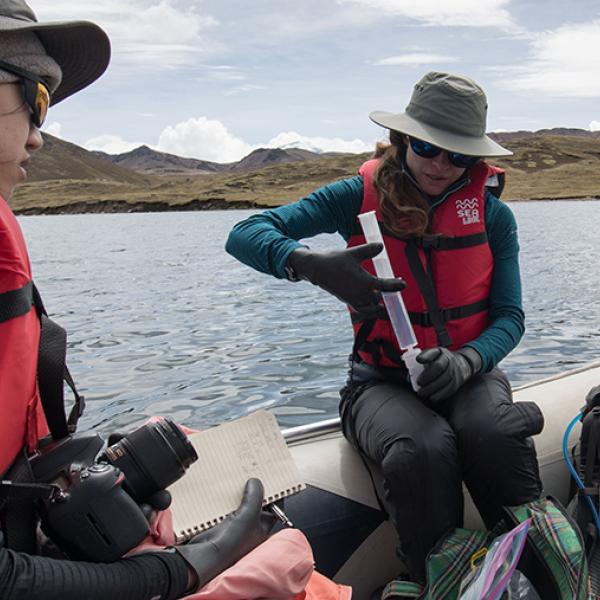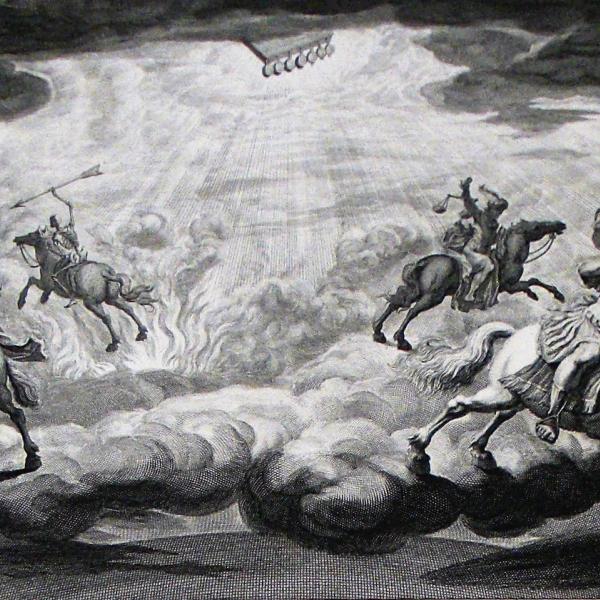
What can a single sheet of paper reveal about the complex life of an artistic genius like Michelangelo Buonarroti? William Wallace, an art historian and author of Michelangelo: The Artist, the Man, and his Times, reveals how documents - including one extremely rare document in Washington University's own library - provide a window into Michelangelo's life and art.
This episode was originally released in April 2016.
Transcript:
Claire Navarro: Hello, and thank you for listening to Hold That Thought. I’m Claire Navarro. To start off this podcast, we have to go back in time a little bit. The year was 1986 here on the campus of Washington University in St. Louis. A student named Larysa Beyer was taking an art history seminar on Michelangelo. While working on a paper for the class, she did what students often do, and went to the library. But instead of looking up one of the many books written about Michelangelo, Larysa decided to check out Special Collections, the section of the library that keeps rare books and original documents.
Bill Wallace: And at the time, we still had a card catalogue, and they looked at the card catalogue, and under M there was a card that said, “Michelangelo.” They brought out a piece of paper. She looked at it. She couldn’t read a word on it. She couldn’t even tell if it was Italian or Latin.
CN: Bill Wallace is a professor of art history at Washington University and a scholar of Michelangelo. At the time, he was Larysa’s teacher. After that visit to the library, weeks went by. Larysa assumed that if a piece of paper handwritten by Michelangelo was just sitting in the library, surely her professor already knew about it. So, it wasn’t until near the end of the semester that she mentioned what she had seen.
BW: I kind of questioned whether she really knew what she was looking at. She said, “Well, it looked like it was on kind of old paper.”
CN: Wallace did not know about the document. Nobody knew about it. So even though he figured it was probably a photocopy or something that she had mistaken, he thought it was worth seeing for himself.
BW: It was a Friday afternoon. It was about 4 o’clock. The rare book collection was going to close at 5, and I said, “Well, why don’t we walk up and take a look?” So we did. They brought out the document. And I must say my heart kind of stopped, because I have looked at a lot of Michelangelo documents in my life, and as soon as I saw this one—he has very distinctive handwriting (we have a lot of Michelangelo handwriting), and there is no doubt what so ever that we have an authentic Michelangelo document in our Washington University library. And it was completely unknown—or completely unpublished—at that time.
"It was a Friday afternoon. It was about 4 o’clock. The rare book collection was going to close at 5, and I said, “Well, why don’t we walk up and take a look?” So we did. They brought out the document. And I must say my heart kind of stopped."
CN: This was a truly shocking thing to find. There are only a handful Michelangelo documents anywhere in the United States. Most of them are in private collections. So it was only after Wallace calmed himself a bit that he began to actually read the piece of paper. What unknown glimpse of Michelangelo’s life might be revealed? Was it a letter? A poem? A plan for a sculpture? Well, not exactly.
BW: The first few lines say, I, Michelangelo Buonarroti, have in my house eight barrels of wine and about two barrels of Fo dig Lioli. And that was a word that kind of threw me at first, because I didn’t recognize what it was. At first, I thought they were beans, but it turned out to be cheap wine, bottom of the barrel type wine. And then he says I have about a half barrel of vinegar and “bocche quattro.” Four mouths. That is he has four people he has to feed in his household; he is responsible for feeding four people.
CN: So, why would a famous artist and sculptor keep detailed records of the wine and vinegar in his house? At first, Wallace didn’t know.
BW: It took us a little while to figure our what he was talking about. You know, was this an inventory of his basement?
CN: A detail on the reverse side of the paper provided some clues. It turns out that this list of wine and vinegar was written in the year 1529 – and that is important. When Michelangelo died in his late 80s – which by the way, was an extraordinary long time for a person to live during the renaissance – he left behind hundreds of pages of personal documents, financial documents, legal documents, and more. So did his family and patrons. But look for documents from 1529, and you’re not going to find much of anything. That’s because 1529 was an extremely dangerous time in the artist’s life. In 1529, Florence was at war. The conflict had started a couple years earlier.
BW: In 1527, Florence decided to declare itself independent, and this is the moment a Florentine was elected Pope. Clement VII was really distressed that his own native city declared itself independent of the Papacy. So Michelangelo had to decide: am I going to choose Florence, or am I going to choose the Pope? He was already working for the Pope, but he chose Florence. That is because first and foremost, an Italian is the city they were born in. They are first and foremost a Florentine and only secondarily an Italian. That’s true even today. So Michelangelo chose to side with Florence. For three years of his life, he devoted himself to his city of Florence, and in a sense, he is a rebel against the very power that previously he had been hired by.
CN: And not just any rebel. You probably think of Michelangelo as the person who painted the ceiling of the Sistine Chapel or the sculptor who made the David, but in 1529, Michelangelo was Florence’s Governor-General of fortifications, building protections to keep out the enemy. The city was under siege, and food was scarce. The Florentine government required its people to declare how much food and liquid they had. This sort of declaration is what Wallace’s student found in the library.
BW: This document is a declaration of liquid goods that are left in the house, and it indicates the very dire straights that the citizenry is going through at this time. There are 50 people dying a day from starvation. Michelangelo is responsible not only for his own household but for the protection of this entire city. This was an extremely dangerous moment, and as we all know, war is not a moment when a lot of documentation takes place or when documents are made, they are generally destroyed. This was a moment of a real void in Michelangelo’s life in terms of what we really know what was happening, so our document gives us a tiny glimpse in a very, very dangerous time in his life.
"Michelangelo is responsible not only for his own household, but for the protection of this entire city. This was an extremely dangerous moment, and as we all know, war is not a moment when a lot of documentation takes place."
CN: Dr. Wallace has been studying the life and works of this one man for close to 40 years, and he’s still constantly fascinated by what he finds. The rare document in the Washington University library helps us understand why. When it comes to Michelangelo, there’s always more to discover. In some ways it seems like this one genius lived many lives all rolled into one.
BW: I think it is one of the things I have most enjoyed about Michelangelo, is that, yes, we all know he was a sculptor. And then we think, “Oh, yes. He also painted the Sistine Chapel.” And then, “Oh, yes. He built St. Peters. He’s an architect.” And I think very few people know he is a really important poet. We have some 300 poems Michelangelo wrote. He is one of the most important poets of the Renaissance. I also think he is the greatest engineer of the Renaissance. We always think of Leonardo as a great Renaissance engineer, but Leonardo thought of a lot of things that did nothing. Michelangelo actually did it. He carried things out. He accomplished remarkable engineering feats, and one of them is that he built fortifications. These fortifications actually worked. So if you think of a Renaissance man, I mean, really Michelangelo is the Renaissance man in accomplishing these things of surprisingly diverse fields of creativity and accomplishment.
CN: It’s a little hard to even wrap your head around how all these diverse areas of creativity and expertise could coexist in one person. Luckily, the immense amount of documentation that Michelangelo left behind provides scholars a window into how all the pieces fit together. When writing a book about Michelangelo’s work designing and building sections of San Lorenzo church in Florence, Wallace came across a piece of paper that revealed Michelangelo the master architect, Michelangelo the project manager, and Michelangelo the poet – all at the same moment.
BW: So while he was at work drawing and designing moldings and bottoms and bases for columns, he will then start to write poetry on the same sheet of paper where he is designing a column. And at the same time, we know that there are 50 people in the same room as him all carving sculpture and making all kinds of noise. Yet he’s writing Petrarchan poetry on the paper. And we can tell he was doing it at the same time because it is folded and it’s all messed up. It’s very clear it’s all being done in the workshop and not at home where it is nice and quiet and clear. Everybody says when we read Michelangelo’s poetry that it has a rocky, rough quality to it. There is a very evident transference of character between his sculpting and his poetry, which is evident right here on this same piece of paper.
CN: When I first heard this story, my immediate thought was – okay, lets forget the word genius – this man was some sort of super-human right? I asked Wallace whether he felt the same. After more than 30 years of studying this one life, is he still in awe, or does Michelangelo seem more like a regular person, someone you could really get to know? The answer for Wallace is both.
BW: I have been working on Michelangelo close to 40 years, and I have come nowhere close to exhausting my interest of him. In fact, he gets more and more interesting. On one hand, I have greater respect for him and more awe of his ability and his accomplishments. On the other hand, I also realize the fallibility and the human quality.
"I have been working on Michelangelo close to 40 years, and I have come nowhere close to exhausting my interest of him."
CN: These human qualities are revealed, once again, through documents and research. These pieces of paper don’t only tell the story of an artistic genius – they tell the day-to-day details of a man’s life. Even details that in other situations, you probably wouldn’t want to know.
BW: Michelangelo does tell his nephew every kidney stone he passes and how large it is. And, you know, because you don’t buy clothes at Wal-Mart during the Renaissance; you buy cloth. And he records every piece of cloth that he buys and what size it is and what color it is, so in a sense, we can reconstruct his entire closet. We can get pretty close to getting some pretty amazing detail. In terms of what he ate, he records many times what he ate for the day, that sort of thing, especially when he is having stomach distress and things like that. We have a wonderful sheet of paper where he records the three meals he has had the last three days.
CN: Over the course of his career, Wallace has used these types of records to piece together a rich picture of Michelangelo’s life – and also his art. Looking at one of Michelangelo’s beautiful sculpture, it’s difficult to imagine how a huge piece of hard rock marble came be transformed into flowing robes or human flesh. By piecing together the clues found in documents, Wallace brings to life a vision of the process and the person.
BW: We tend to celebrate the Sistine Ceiling, the carving of the David, but carving marble is a lot of work. It is just very, very difficult manual labor, and transporting a block of marble that weighs eight tons 90 miles, you have to figure out how to do it. Nobody had done it since the Romans 1000 years before, but Michelangelo was doing it on the scale of the Romans. He was, in a sense, reinventing the logistics of transport, the mechanics, and the making of art in the scale and complexity of the Roman Empire all over again. That is what we call the Renaissance: the rebirth of antiquity. In a sense, Michelangelo is really at the center of helping that happen in certain ways. I think it helps us appreciate it all the more to realize the technical difficulty of carving a sculpture that’s 17 feet high, to imagine setting that block up and having it be noting but raw stone and then imagining a figure in it and realizing that as you carve the head, you can’t even see the feet, because you are on a scaffold. The scaffolding is blocking your view of the middle part of the figure, but then you are at the middle part and you can’t even see the head. Or painting the Sistine Ceiling, some of those prophets are 14 feet tall, and they are on a curved surface. You have to imagine what that figure is going to look like; a figure 14 feet high on a curved surface, seated, has got to look exactly right and perfect from 60 feet down below. It is really just astonishing that he has the capacity and ability to carry these out, and yet we don’t even think about the technical difficulty because we are so overwhelmed by the artistic accomplishment. I like what Johann Goethe said about the Sistine Ceiling: “Until you have seen the Sistine Ceiling, you have no idea what human kind is capable of accomplishing.” That’s a remarkable statement.
CN: For much more on the life of this inspiring artist, you can check out any of William Wallace’s several books on Michelangelo, including Michelangelo: The Artist, the Man, and his Times. Or, for many more ideas to explore from the scholars at Washington University in St. Louis, please visit our website, holdthatthought.wustl.edu. You can also find us on Facebook or Twitter or find our weekly podcasts on iTunes, Stitcher, SoundCloud, or PRX. Thanks for listening.
Credits:
Free Music Archive Broke for Free, Discount Fireworks, Rumbus Merrylegs; YouTube Baroquewithlove, Early Classical Music/Jon Sayles




